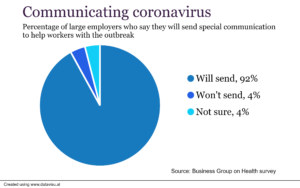
What are the right ways for HR to handle coronavirus concerns in the workplace?

The right ways for HR to handle coronavirus concerns in the workplace

The COVID-19 coronavirus became the accelerator for one of the greatest workspace transformations of our lifetime. How we work, with whom we work, where we work, how we communicate and the ways we learn got changed completely. It has taken a few weeks for the COVID-19 to shut down most restaurants, malls, shops, and gyms. To stop spreading of this contagious disease govt encourage 88% of workers to work from home, despite whether or not they are showing symptoms of coronavirus.
It leads businesses to analyze current policies in favour of smarter ways to prevent workplace contamination and calm employee anxiety. But the larger question is: how this massive transformation will impact the workplace, you, your team, and your organization? Here are our insights on how HR should handle coronavirus concerns.

How should HR to handle coronavirus concerns in the workplace?

- Transparent communication to employees
Communication and decisive action help both to inform employees about changes in company policies and to assuage anxiety and fear. Be accurate, prompt, and honest in your communications. Outline the measures you are taking and why you are taking them.
HR to handle coronavirus concerns in the workplace is crucial at the times of a pandemic.
Adopt a multi-pronged approach for communicating to your HR team. Use electronic means but adopt physical communication methods as well.
Send an email to reassure employees you are paying close attention to the virus, and it’s spread. Explain the precautions you are taking to keep the office and your worker safe. Share reputable sources for information like the CDC and WHO. Designate a point of contact for COVID-19-related queries in the HR department.
Post notices around the workspace with the signs and symptoms to watch out for (cough, fever, and shortness of breath). And to remind workers proper cough etiquette and hygiene.
- Limit employee travel
Curb the travel plans of your employee as much as possible. Postpone or cancel business trips to any of the nations that have been granted level-3 travel restriction by the CDC.
- Cancel face-to-face meetings
Minimize person-to-person contact by cancelling face-to-face meetings. We know it’s hard to replicate the rapport you can build in face-to-face meetings, especially with new clients or business partners. But keeping everyone healthy and safe is what’s most important right now. You can go for video conferences or a good old fashion phone call.
- Make a pandemic plan
If your SMB does not have a documented pandemic plan yet, it’s the time to make one. Answer these questions:
- Can our firm operate with 25% or greater employee absenteeism?
- If illness causes high absenteeism, are workers cross-trained and able to perform multiple duties?
- Can our employees work remotely?
- What is infrastructure support needed to support a shift to employees working at home?
- Will our firm monitor, or restrict, employees travel to high-risk regions?
- What assurances should we provide to the employees, so they feel safe at work?
- How will travelling employees be brought home, particularly if they are ill?
- Is there an escalation procedure to get additional resources?
- Is there a well-trained and representative crisis management team that involves on-call staff? And do those teams know what is expected of them?
Answering there queries are essential for your company to decide the next step.
- Ask sick employees to stay home
Sick employees should stay home, point-blank. Signs of a COVID-19 infection can be mild. It takes five days on average to show up. So, workers who have been in contact with an ill person should also stay at home. Inform employees who have fevers to stay home for fourteen days to make sure they are COVID-19-free.
- Reconsider leave policies
Whether they are dedicated employees who want to put in face time or employees who have already used up their sick pay, they will show hesitant to stay home when unwell.
Do not wanting to forgo a paycheck is a powerful motivator for them coming into work, especially when you have a sore throat and case of the sniffles. But this is particularly dangerous. The symptoms for 80% of coronavirus patients are more cold-like than anything else.
It is up to HR departments and SBOs to lift any barriers to entry for unwell employees. Encourage sick workers to stay at their home, no matter how “well” they may feel by rethinking your leave and PTO policies. Even though not every business can go as far as Apple is offering unlimited sick leave to retail employees, employers should analyse what leniency they can grant regarding sick leave.
- Place restrictions on returning to work
Employees coming back from countries experiencing major outbreaks should stay home from work. These countries currently include India, China, South Korea, Italy, Iran, and many more countries around the world are added to the list.
- Consider remote work
Work from home arrangement is the best answer to stalling the coronavirus spread in the workplace. For some firms and roles, the transition is easier than others. Consider these scenarios.
- When remote work is not possible
There are some industries that rely on the presence of physical workers. In healthcare, hospitality, manufacturing, and retail WFM are not always possible. In these scenarios, the HR department and business owners have to answer difficult questions about how to protect employees, customers, and the workplace. It may mean operating with a reduced staff level or even closing during peak employee absenteeism.
- When remote work is possible but not ideal
Sales and marketing job roles still rely massively on face-to-face contact and relationship building. Provide logistical and emotional support for the cultural changes this adjustment will entail.
- When remote work is highly possible
Developer teams and off-site contractors are already well-used to collaborating virtually across geographical lines and time zones. Encourage these people to stay at home and continue to support them as usual.
Think long term
Remember that the disaster will pass. How will your workers and customers remember your businesses’ response? Resilient, prepared, and people-first leadership will carry you through to the other side.




